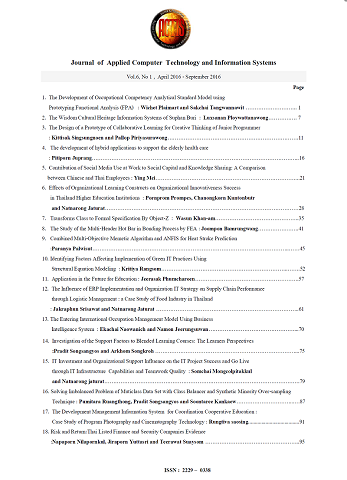The Study of the Multi-Header Hot Bar in Bonding Process by FEA
Main Article Content
Abstract
The reflow interconnection is a common connection between the head gimbal assembly (HGA) and the E-Block in a manufacturing process of hard disk drive. Sometimes the interconnection process is called lapping bonding. At present, the reflow process uses one header of the hot bar at a time for bonding. However, time to market is very important. Such the approach is time consuming for the hard disk drive production. In this study, the finite element method was used for improvement the reflow process which twelve headers of the hot bar were used at a time for bonding. The even number of the hot bars was recommended. In addition, the heat transfer was considered carefully by control the hottest area and uniformity of the heat distribution on the reflow area. The results from peel test and electrical test revealed that the quality of lapping bonding by multi header can be compared with that by one header. Increasing of the hot bar header is able to increase the percent of UPH as well.
การเชื่อมแบบกดทับเป็นวิธีการที่นิยมในการเชื่อม หาง TGA (Trace Gimbal Assembly) เข้ากับอีบล็อค (E-Block) บางครั้งเรียกว่ากระบวนการรี โฟลว์ (Reflow) ซึ่งเป็น กระบวนการหนึ่งในกระบวนการผลิตฮาร์ดดิสก์ไดร์ (Hard Disk Drive) การเชื่อมโดยใช้แท่งเชื่อม (Hot Bar) ครั้งละหนึ่ง หัวดังเช่นที่เคยทำกันมาอย่างต่อเนื่องตั้งแต่ในอดีต ทำให้ต้อง สูญเสียเวลาในการผลิตฮาร์ดดิสก์ไดร์ฟมาก จากการศึกษาโดย ใช้ระเบียบวิธีไฟไนท์เอลิเมนต์ทาให้สามารถปรับปรุงวิธีการ เชื่อมให้เชื่อมได้ครั้งละหลายๆ หัว เพื่อช่วยลดเวลาในการผลิต ฮาร์ดดิสก์ไดร์ฟ จากการทดสอบพบว่า ค่ายูนิตต่อชั่วโมง (Unit Per Hour, UPH) ของกระบวนการเชื่อมเพิ่มขึ้นถึง 80 เปอร์เซนต์ ยิ่งเพิ่มจำนวนหัวเชื่อมจำนวนเปอร์เซนต์ก็เพิ่มขึ้น ตามไปด้วย ในขณะที่คุณภาพของการเชื่อมยังคงเดิมเมื่อเทียบ กับการเชื่อมครั้งละหนึ่งหัว
Article Details
It is the policy of ACTISNU to own the copyright to the published contributions on behalf of the interests of ACTISNU, its authors, and their employers, and to facilitate the appropriate reuse of this material by others. To comply with the Copyright Law, authors are required to sign an ACTISNU copyright transfer form before publication. This form, a copy of which appears in this journal (or website), returns to authors and their employers full rights to reuse their material for their own purposes.

